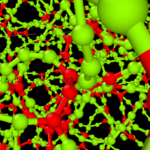This paper is an account of my undergraduate thesis research.
Full Report
Abstract
Gel-like materials are ubiquitous in modern manufactured products, the human body, and food. Further advanced applications of gels require producing gels with finely tuned mechanical responses. However, such tuning requires an understanding of how these responses originate in the microscopic properties of the gel’s molecular network, such as the bending rigidity of gel network branches. This investigation relies on 3D computer simulations to study how the bending rigidity affects a gel’s mechanical response to shear strain. Increased bending rigidity decreases both the critical strain at which the gel’s load curve switches from linear to nonlinear, as well as the yield strain. Overall, the nonlinear regime becomes shorter. This is similar to the effects of increased network density, likely because both bending rigidity and high density restrict the network’s ability to rearrange in response to deformation. In addition to the supporting data, this text describes the main physical properties of the soft gels that motivated the study, the numerical approach taken to simulate the gel, and important questions to investigate in further studies.

